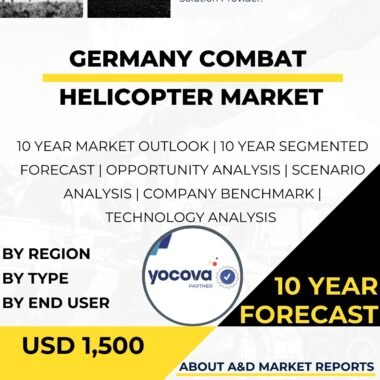Description
The combat helicopter market in Malaysia has become a crucial aspect of the country’s defense modernization efforts and military capability enhancement. As a nation with strategic significance in Southeast Asia, Malaysia recognizes the importance of having a well-equipped and capable combat helicopter fleet to support its defense posture, conduct military operations, and respond effectively to various security challenges.
Combat helicopters are versatile military aircraft designed for a wide range of roles, including troop transport, close air support, anti-tank warfare, reconnaissance, and search and rescue missions. These helicopters play a vital role in enhancing the operational effectiveness and versatility of the Malaysian Armed Forces.
The combat helicopter market in Malaysia has evolved to address the changing nature of modern warfare and the need for advanced aerial capabilities. The government’s focus on enhancing aerial capabilities includes the acquisition of state-of-the-art combat helicopters equipped with advanced sensors, avionics, and weaponry.
One of the primary objectives of Malaysia’s combat helicopter market is to enhance operational capabilities and readiness. Combat helicopters provide essential support to ground forces, transport troops to remote areas, conduct reconnaissance, and engage enemy targets effectively. The integration of combat helicopters into the Malaysian Armed Forces significantly enhances their operational agility and response capabilities.
The acquisition of combat helicopters is part of Malaysia’s broader defense modernization efforts. Collaborations with international defense companies have facilitated access to advanced combat helicopter technologies and expertise. These partnerships have also allowed for technology transfer and knowledge exchange, contributing to the growth of the domestic defense industry.
Moreover, Malaysia has also demonstrated interest in developing indigenous combat helicopter capabilities. Collaborations between local defense companies and foreign manufacturers have facilitated technology transfer and knowledge exchange, fostering the growth of the domestic defense industry and contributing to economic development.
In addition to their roles in combat missions, combat helicopters also play a significant role in search and rescue operations and disaster relief efforts. Their ability to access remote and difficult-to-reach areas makes them valuable assets in supporting humanitarian initiatives and civil applications.
Training and education are critical aspects of the combat helicopter market in Malaysia. Proper training of helicopter pilots and ground crews ensures that they are proficient in operating and maintaining combat helicopters effectively. Regular training exercises contribute to enhancing the effectiveness of helicopter operations and response capabilities.
Challenges in the Malaysian combat helicopter market include budgetary considerations and operational logistics. The acquisition and maintenance of advanced combat helicopters can be costly, requiring careful planning and prioritization of defense expenditure.
Moreover, combat helicopters require a robust logistics infrastructure to support their operations. Adequate maintenance facilities, spare parts availability, and trained personnel are essential to ensure the reliability and availability of combat helicopters.
Environmental factors, such as weather conditions and geographic challenges, can also pose obstacles to helicopter operations. Proper planning and operational protocols are necessary to ensure the safety and effectiveness of combat helicopter missions under various environmental conditions.
The combat helicopter market in Malaysia is also influenced by international norms and agreements related to arms control and non-proliferation efforts. Malaysia adheres to international regulations and guidelines, ensuring responsible use and deployment of combat helicopters in accordance with international norms.
In conclusion, the combat helicopter market in Malaysia plays a significant role in the country’s defense strategy and capability enhancement efforts. The adoption of advanced combat helicopter technologies enhances operational capabilities, readiness, and response effectiveness. Collaborations with international partners and indigenous research and development efforts contribute to Malaysia’s strategic capabilities and the growth of the domestic defense industry. The government’s commitment to aerial capabilities and the development of indigenous helicopter technologies demonstrate Malaysia’s dedication to strengthening its defense capabilities and addressing various security challenges. Additionally, the versatility of combat helicopters extends beyond military applications to support search and rescue operations, disaster relief efforts, and civil initiatives, contributing to national security, public safety, and humanitarian assistance.




